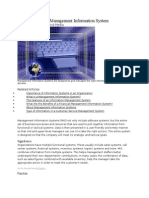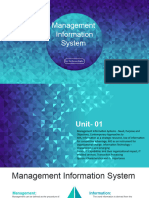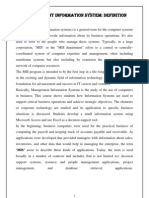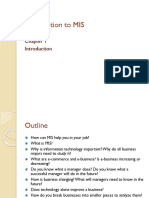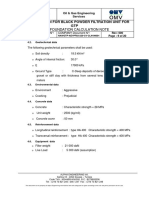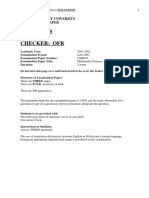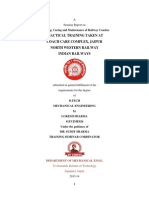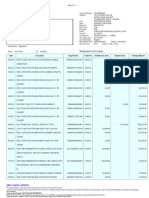Sarala Birla University
BBA Sem III
Course Title: Management Information System
Course Code: BBA 303
Module II: MIS
Nature, Scope, Characteristics, Functions
Hardware and Software Concepts: Types of Data, Hardware Components
Nature of Management Information System
Management Information Systems (MIS) can be simply referred to as a system or process that
facilitates the smooth working of the organisation. The nature of MIS is truly multifold because
it plays a bigger role in business decisions, from costs to employee management. Here are the
major features that portray the nature of MIS:
1. MIS is utilised by every level of a management.
2. It clarifies and focuses on the strategic goals and objectives for the management.
3. MIS provides an effective system to analyse costs and revenues and further reviews
effectively and efficiently to bring a balanced in finances and costs.
4. MIS is maintained either through manual systems or automated systems or a
combination of both.
5. It also plays an incremental role in identifying, locating, measuring, tackling and
limiting risks.
6. It lays down a framework of rules and regulations for the management to bring a clear
and concise communication between employees.
7. MIS provides an objective system of collecting, assessing and aggregating information
for a business.
Scope of MIS
After understanding what is MIS and the nature of management, we move on to the scope of
MIS. Information Systems is growing at a fast pace to become one of the most promising career
fields in today’s world. With everything happening digitally, the demand for MIS professionals
is increasing more than ever. MIS involves performing a number of tasks simultaneously such
as-
1. Processing data
2. Initiating transactions
3. Responding to inquiries
4. Producing reports and its summaries
5. Manage the data created within the structure of a particular business
1
�MIS acsts in an organization just like a nervous system in a body by providing with the relevant
information for ease in the process of decision making.
The purpose of MIS is to work towards satisfying the information needs of everyone in the
business. It means providing the relevant information to those who need it.
Thus, MIS has a lot of potential to become one of the most promising careers for individuals
interested in the workings of a business.
Characteristics or Objectives of Management Information System
When any organization wishes to establish the MIS, it must be very clear about the need of
information required by the different levels of management.
Followings are the reasons for the adoption of the MIS:
1. To provide information for planning, organizing and controlling purposes.
2. To store and manage data efficiently from all the functional areas of the business.
3. To process the collected data and derive information out of them.
4. To provide information quickly as and when required.
5. To reduce the risk and uncertainties in the managerial decision-making.
6. To collect and store the data for the purpose of internal research.
7. To assist in identifying the managerial problems and their solution.
8. To provide information regarding work force planning.
9. To provide the information regarding the financial health of the business organization.
10. To provide information regarding production and inventory.
11. To provide information regarding sales and other marketing aspects i.e., product, price,
promotion, market, physical distribution, payment collection, market segmentation etc.
12. To speed up the execution of the results with the reliable data available.
13. To smooth up the flow of data through various levels of the organization.
14. To provide information regarding work force planning.
15. To provide the information regarding the financial health of the business organization.
16. To speed up the execution of the results with the reliable data available.
2
� 17. To smooth up the flow of data through various level of the organization.
Functions or Importance of Management Information System
In present business organizations, MIS play a very important role. It is a process of collection
and storing of the data useful for the organization. Executives retrieve these data, when required
and processed them for generating information. Executives determine the future course of
action of the organization over the long and short-term periods.
The responsibility of corporate executives is decision making, laying down policy, planning,
organizing, controlling, directing, communicating and motivating, evaluating and gathering
things done to meet the overall objectives and goals of organization. MIS provides information
regarding all these aspects of managing.
Previously, the business organizations were not perceived as a system. All the functional areas
were independent and there was not a cross discussion amongst the managers of different
functional areas. At that time, sale was considered only the marketing phenomenon and the
sale force was solely responsible for the achievement of the sales target.
However, in present days, all departments hold equal responsibility. If there is any problem in
selling goods, all the members concerned of Marketing and Production departments sit together
and find out the fault after recognizing the problem(s). Appropriate steps are taken to find out
the ways to achieve the sales target. This mechanism helps the organization to achieve its
objectives efficiently and economically.
Thus, the following points can summarize the importance of MIS:
1. It helps in minimizing risk in decision making.
2. It processes the data and derives information out of them.
3. It provides information about the various aspects of business.
4. It helps the executives to avail the information regarding the functional areas quickly.
5. The database helps in inducting research. The data stored are used as secondary data.
6. It provides sound information regarding the financial health of business organization.
7. It helps in preparing corporate report.
8. It helps the HRD manager in finding out the requirement of the human resource, their
wages and salary, performance appraisal, training, promotion, absenteeism and
employee’s turnover, which is useful in drafting sound HRD polices.
9. The data regarding production helps the production manager in deciding about capacity
utilization, number of rejections per batch, frequency of break down, status of shipment
of processed order and product, region wise.
3
� 10. It provides information regarding inventory position, and ensures that the chances of
inventory out of stock may be minimized.
11. It provides information regarding product, price, promotion, segmentation, demand,
sale etc. to marketing manager instantly and ensures smooth functioning of that
department.
At present, every business organization is giving due importance to this department. The credit
of growth and development of many of the business organizations goes to it. If organization
underestimates the importance of MIS, they may have greater changes of generating negative
profit.
Limitations of Management Information System :
1. MIS takes into account mainly quantitative factors; thus, it ignores the non-quantitative
factors like morale, attitudes of members of the organization, which have an important
bearing on the decision-making process of executives.
2. MIS is less useful for making non-programmed decision making. Such types of
decisions are not of routine type and thus they require information, which may not be
available from existing MIS to executives. MIS effectiveness decreases due to frequent
changes in top management, organizational structure and operational team.
3. MIS is not a substitute for effective management. It means that it cannot replace
managerial judgement in making decisions in different functional areas. It is merely an
important tool in the hands of executives for decision making and problem solving.
4. The quality of the outputs of MIS is basically governed by the quality of inputs and
processes.
5. MIS may not have requisite flexibility to quickly update itself with the changing needs
of time, especially in a fast changing and complex environment.
6. The effectiveness of MIS is reduced in organization, where the culture of hoarding
information and not sharing with others hold.
7. MIS cannot provide tailor made information packages suitable for the purpose of every
type of decision made by executives.
Hardware and Software Concepts: Types of Data, Hardware Components
Data is defined as a body of facts or figures, gathered together for a specific purpose.
Information is basically a processed form of data which helps in better decision making.
Information Technology (IS) is a set of components that collects, process, store and distribute
information to support decision making, control and coordination in an organization. It may
also help the managers to analyze problems, visualize complex subjects and create new
products.
4
�Components of IS –
1. Hardware
2. Software
3. Data
4. People
5. Procedures
Hardware and Software Concepts
Hardware
The term hardware refers to mechanical device that makes up computer. Computer hardware
consists of interconnected electronic devices that we can use to control computer’s operation,
input and output. Examples of hardware are CPU, keyboard, mouse, hard disk, etc.
Hardware Components
Computer hardware is a collection of several components working together. Some parts are
essential and others are added advantages. Computer hardware is made up of CPU and
peripherals as shown in image below.
5
�Software
A set of instructions that drives computer to do stipulated tasks is called a program. Software
instructions are programmed in a computer language, translated into machine language, and
executed by computer. Software can be categorized into two types −
System Software : System software operates directly on hardware devices of
computer. It provides a platform to run an application. It provides and supports user
functionality. Examples of system software include operating systems such as
Windows, Linux, Unix, etc.
Application Software: An application software is designed for benefit of users to
perform one or more tasks. Examples of application software include Microsoft Word,
Excel, PowerPoint, Oracle, etc.
Differences between Software and Hardware are sorted out below –
Sl.No. Software Hardware
1 It is a collection of programs to It includes physical components of
bring computer hardware system computer system.
into operation.
2 It includes numbers, alphabets, It consists of electronic components like
alphanumeric symbols, identifiers, ICs, diodes, registers, crystals, boards,
keywords, etc. insulators, etc.
3 Software products evolve by adding Hardware design is based on architectural
new features to existing programs decisions to make it work over a range of
to support hardware. environmental conditions and time.
4 It will vary as per computer and its It is mostly constructed for all types of
built-in functions and programming computer systems.
language.
5 It is designed and developed by The hardware can understand only low-
experienced programmers in high- level language or machine language.
level language.
6
� 6 The hardware works only on binary codes
1’s and 0’s.
It is represented in any high-level
language such as BASIC, COBOL,
C, C++, JAVA, etc.
7 The software is categorized as The hardware consists of input devices,
operating system, utilities, language output devices, memory, etc.
processor, application software, etc.
Types of Data
1. Quantitative data
Quantitative data seems to be the easiest to explain. It answers key questions
such as “how many, “how much” and “how often”.
7
� Quantitative data can be expressed as a number or can be quantified. Simply
put, it can be measured by numerical variables.
Quantitative data are easily amenable to statistical manipulation and can be
represented by a wide variety of statistical types of graphs and charts such as
line, bar graph, scatter plot, and etc.
Examples of quantitative data:
Scores on tests and exams e.g., 85, 67, 90 and etc.
The weight of a person or a subject.
Your shoe size.
The temperature in a room.
2. Qualitative data
Qualitative data can’t be expressed as a number and can’t be measured.
Qualitative data consist of words, pictures, and symbols, not numbers.
Qualitative data is also called categorical data because the information can be
sorted by category, not by number.
Qualitative data can answer questions such as “how this has happened” or and
“why this has happened”.
Examples of qualitative data:
Colours e.g., the colour of the sea
Your favourite holiday destination such as Hawaii, New Zealand and etc.
Names as John, Patricia,…..
8
�3. Nominal data
Nominal data is used just for labelling variables, without any type of
quantitative value. The name ‘nominal’ comes from the Latin word “nomen”
which means ‘name’.
The nominal data just name a thing without applying it to order. Actually, the
nominal data could just be called “labels.”
Examples of Nominal Data:
Gender (Women, Men)
Hair colour (Blonde, Brown, Brunette, Red, etc.)
Marital status (Married, Single, Widowed)
Ethnicity (Hispanic, Asian)
4. Ordinal data
Ordinal data shows where a number is in order. This is the crucial difference
from nominal types of data.
Ordinal data is data which is placed into some kind of order by their position on
a scale. Ordinal data may indicate superiority.
However, you cannot do arithmetic with ordinal numbers because they only
show sequence.
Ordinal variables are considered as “in between” qualitative and quantitative
variables.
In other words, the ordinal data is qualitative data for which the values are
ordered.
In comparison with nominal data, the second one is qualitative data for which
the values cannot be placed in an ordered.
We can also assign numbers to ordinal data to show their relative position. But
we cannot do math with those numbers. For example: “first, second,
third…etc.”
Examples of Ordinal Data:
The first, second and third person in a competition.
Letter grades: A, B, C, and etc.
When a company asks a customer to rate the sales experience on a scale of 1-
10.
Economic status: low, medium and high.
9
�5. Discrete data
Discrete data is a count that involves only integers. The discrete values cannot
be subdivided into parts.
For example, the number of children in a class is discrete data. You can count
whole individuals. You can’t count 1.5 kids.
To put in other words, discrete data can take only certain values. The data
variables cannot be divided into smaller parts.
It has a limited number of possible values e.g., days of the month.
Examples of discrete data:
The number of students in a class.
The number of workers in a company.
The number of home runs in a baseball game.
The number of test questions you answered correctly
6. Continuous data
Continuous data is information that could be meaningfully divided into finer
levels. It can be measured on a scale or continuum and can have almost any
numeric value.
For example, you can measure your height at very precise scales — meters,
centimetres, millimetres and etc.
You can record continuous data at so many different measurements – width,
temperature, time, and etc. This is where the key difference from discrete types
of data lies.
The continuous variables can take any value between two numbers. For
example, between 50 and 72 inches, there are literally millions of possible
heights: 52.04762 inches, 69.948376 inches and etc.
A good great rule for defining if a data is continuous or discrete is that if the
point of measurement can be reduced in half and still make sense, the data is
continuous.
Examples of continuous data:
The amount of time required to complete a project.
The height of children.
The square footage of a two-bedroom house.
The speed of cars.
10
�Conclusion
All of the different types of data have a critical place in statistics, research, and data science.
Data types work great together to help organizations and businesses from all industries build
successful data-driven decision-making process.
11

















